|
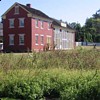
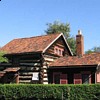
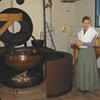
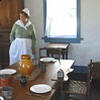
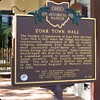 I quickly realized that Zoar was likely the highlight of the trip and I
had almost missed it. The settlement was started in 1817 by a group of
German Separatists lead by Joseph Baumeler. After only a couple of years
struggling as individual farmers, the group decided that socialism was the
only way to survive and a commune was formed in 1819 that accomplished its
goal and continued until 1898. Today the town is a mixture of privately
owned residences and businesses and a number of buildings maintained by
the Ohio Historical
Society. Part of the mission of the
Zoar Community
Association is "to ensure the preservation of the historical
characteristics and heritage of the Village of Zoar..." Maps are
available to facilitate a self guided tour and two guided tours are
available for reasonable fees. I took advantage of both tours. One
concentrates on the home life of the Zoarites and was conducted, on this
day, by Sally. Lisa was our guide for the second tour, which showed more
of the community's working side. Before heading out on the tours, you can
get a good overview of the Zoar story from a short video.
I quickly realized that Zoar was likely the highlight of the trip and I
had almost missed it. The settlement was started in 1817 by a group of
German Separatists lead by Joseph Baumeler. After only a couple of years
struggling as individual farmers, the group decided that socialism was the
only way to survive and a commune was formed in 1819 that accomplished its
goal and continued until 1898. Today the town is a mixture of privately
owned residences and businesses and a number of buildings maintained by
the Ohio Historical
Society. Part of the mission of the
Zoar Community
Association is "to ensure the preservation of the historical
characteristics and heritage of the Village of Zoar..." Maps are
available to facilitate a self guided tour and two guided tours are
available for reasonable fees. I took advantage of both tours. One
concentrates on the home life of the Zoarites and was conducted, on this
day, by Sally. Lisa was our guide for the second tour, which showed more
of the community's working side. Before heading out on the tours, you can
get a good overview of the Zoar story from a short video.
There were no single family dwellings in Zoar nor were they multi-family
in the way we might think of today. The houses were not divided into
distinct "apartments" - all residents of a house lived as a
group. Almost every item surrounding Sally in the photo came from a home
in Zoar and all but a few were also made there. That statement holds true
for just about every building on the tours. Lisa is seen in the cheese
room where milk was cooked down to curds in the big kettle. The curved
"door" closes to cover the fire making it quite efficient and
safe. The pictured log cabin is the very first structure built in 1817. It
is in private hands and, although not occupied full time, is still used as
a residence when the owners are in town. The wall of windows marks the
next building as a greenhouse and the picture was taken across a corner of
the large community garden. The greenhouse was heated by an under floor
furnace and lemons, kumquats, and other tropical fruits were grown there.
|
|
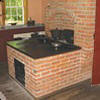
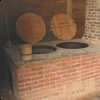
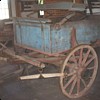
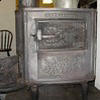
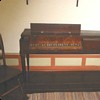 The first picture is the cooking stove of the Number 1 House (houses were
identified by number) and the second is the laundry room. Note that the
fire areas are enclosed on both; A common characteristic of working fires
in Zoar. A fellow named Steve was tending the Number 1 House when I was
there and had bread pudding cooking on the stove. The side of the room
across from the iron wash & rinse bowls is open and lines for drying
run along it. The wagon and furnace illustrate the type of items the
Zoarites were capable of making and offer a real hint at just how self
sufficient they were. Even the piano was made in Zoar.
The first picture is the cooking stove of the Number 1 House (houses were
identified by number) and the second is the laundry room. Note that the
fire areas are enclosed on both; A common characteristic of working fires
in Zoar. A fellow named Steve was tending the Number 1 House when I was
there and had bread pudding cooking on the stove. The side of the room
across from the iron wash & rinse bowls is open and lines for drying
run along it. The wagon and furnace illustrate the type of items the
Zoarites were capable of making and offer a real hint at just how self
sufficient they were. Even the piano was made in Zoar.
|
|

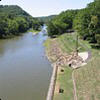
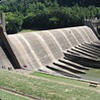 From Zoar, I followed the last few miles of the
CanalWay Ohio Scenic Byway which passes by
Dover Dam. The court house is in New Philadelphia,
Tuscarawas County.
From Zoar, I followed the last few miles of the
CanalWay Ohio Scenic Byway which passes by
Dover Dam. The court house is in New Philadelphia,
Tuscarawas County.
|
|
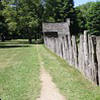
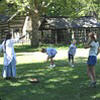
 I bypassed Schoenbrunn Village yesterday but finally made it
today. Schoenbrunn was actually established by the Moravians before
Gnadenhutten but was abandoned along with the other settlements and
never reestablished. That is what makes Gnadenhutten "Ohio's
Oldest Existing Settlement". Everything here is, of course,
reconstructed but the cabins and "streets" are located where
the originals were. The museum offers an orientation video and a self
paced "guided" tour via audio cassette player.
I bypassed Schoenbrunn Village yesterday but finally made it
today. Schoenbrunn was actually established by the Moravians before
Gnadenhutten but was abandoned along with the other settlements and
never reestablished. That is what makes Gnadenhutten "Ohio's
Oldest Existing Settlement". Everything here is, of course,
reconstructed but the cabins and "streets" are located where
the originals were. The museum offers an orientation video and a self
paced "guided" tour via audio cassette player.
|
|
 I followed no particular course from Schoenbrunn but eventually settled
on SR-16 near Coshocton. I was vaguely aware of the fuel situation and,
having ignored numerous gas stations, I wasn't entirely surprised when
the "RESERVE FUEL" message appeared. Even though I was on an
unusually (for me) civilized stretch of highway, it was an unfamiliar
stretch and one where there was no visible evidence of a gas station. As
miles went by and no station appeared, my concern increased. And then, in
the distance, to the left of the road, I saw a large block shape with a
hollow semi-circle rising from it. Perhaps trained by a couple of days of
exposure to old stuff, my mind thought it looked like a Conestoga wagon
coming head-on with the canvas off of the bows. Had my growing panic over
fuel led to hallucinations? I wasn't entirely reassured when it turned
into an equally incongruous 100 foot high picnic basket but the sight of a
Shell station at the next corner triggered a huge sigh of relief. A full
tank did not make the basket disappear so I approached closer to take this
picture. Turns out this is the home office of the
Longaberger
Baskets. I'm not all that familiar with some of life's "finer
things" and only later found out that the whimsical building is
actually less bizarre than the prices obtained for the company's products.
I followed no particular course from Schoenbrunn but eventually settled
on SR-16 near Coshocton. I was vaguely aware of the fuel situation and,
having ignored numerous gas stations, I wasn't entirely surprised when
the "RESERVE FUEL" message appeared. Even though I was on an
unusually (for me) civilized stretch of highway, it was an unfamiliar
stretch and one where there was no visible evidence of a gas station. As
miles went by and no station appeared, my concern increased. And then, in
the distance, to the left of the road, I saw a large block shape with a
hollow semi-circle rising from it. Perhaps trained by a couple of days of
exposure to old stuff, my mind thought it looked like a Conestoga wagon
coming head-on with the canvas off of the bows. Had my growing panic over
fuel led to hallucinations? I wasn't entirely reassured when it turned
into an equally incongruous 100 foot high picnic basket but the sight of a
Shell station at the next corner triggered a huge sigh of relief. A full
tank did not make the basket disappear so I approached closer to take this
picture. Turns out this is the home office of the
Longaberger
Baskets. I'm not all that familiar with some of life's "finer
things" and only later found out that the whimsical building is
actually less bizarre than the prices obtained for the company's products.
|
|
|
Previous Page
|
|




 I quickly realized that Zoar was likely the highlight of the trip and I
had almost missed it. The settlement was started in 1817 by a group of
German Separatists lead by Joseph Baumeler. After only a couple of years
struggling as individual farmers, the group decided that socialism was the
only way to survive and a commune was formed in 1819 that accomplished its
goal and continued until 1898. Today the town is a mixture of privately
owned residences and businesses and a number of buildings maintained by
the Ohio Historical
Society. Part of the mission of the
Zoar Community
Association is "to ensure the preservation of the historical
characteristics and heritage of the Village of Zoar..." Maps are
available to facilitate a self guided tour and two guided tours are
available for reasonable fees. I took advantage of both tours. One
concentrates on the home life of the Zoarites and was conducted, on this
day, by Sally. Lisa was our guide for the second tour, which showed more
of the community's working side. Before heading out on the tours, you can
get a good overview of the Zoar story from a short video.
I quickly realized that Zoar was likely the highlight of the trip and I
had almost missed it. The settlement was started in 1817 by a group of
German Separatists lead by Joseph Baumeler. After only a couple of years
struggling as individual farmers, the group decided that socialism was the
only way to survive and a commune was formed in 1819 that accomplished its
goal and continued until 1898. Today the town is a mixture of privately
owned residences and businesses and a number of buildings maintained by
the Ohio Historical
Society. Part of the mission of the
Zoar Community
Association is "to ensure the preservation of the historical
characteristics and heritage of the Village of Zoar..." Maps are
available to facilitate a self guided tour and two guided tours are
available for reasonable fees. I took advantage of both tours. One
concentrates on the home life of the Zoarites and was conducted, on this
day, by Sally. Lisa was our guide for the second tour, which showed more
of the community's working side. Before heading out on the tours, you can
get a good overview of the Zoar story from a short video.




 The first picture is the cooking stove of the Number 1 House (houses were
identified by number) and the second is the laundry room. Note that the
fire areas are enclosed on both; A common characteristic of working fires
in Zoar. A fellow named Steve was tending the Number 1 House when I was
there and had bread pudding cooking on the stove. The side of the room
across from the iron wash & rinse bowls is open and lines for drying
run along it. The wagon and furnace illustrate the type of items the
Zoarites were capable of making and offer a real hint at just how self
sufficient they were. Even the piano was made in Zoar.
The first picture is the cooking stove of the Number 1 House (houses were
identified by number) and the second is the laundry room. Note that the
fire areas are enclosed on both; A common characteristic of working fires
in Zoar. A fellow named Steve was tending the Number 1 House when I was
there and had bread pudding cooking on the stove. The side of the room
across from the iron wash & rinse bowls is open and lines for drying
run along it. The wagon and furnace illustrate the type of items the
Zoarites were capable of making and offer a real hint at just how self
sufficient they were. Even the piano was made in Zoar.


 From Zoar, I followed the last few miles of the
CanalWay Ohio Scenic Byway which passes by
Dover Dam. The court house is in New Philadelphia,
Tuscarawas County.
From Zoar, I followed the last few miles of the
CanalWay Ohio Scenic Byway which passes by
Dover Dam. The court house is in New Philadelphia,
Tuscarawas County.


 I bypassed Schoenbrunn Village yesterday but finally made it
today. Schoenbrunn was actually established by the Moravians before
Gnadenhutten but was abandoned along with the other settlements and
never reestablished. That is what makes Gnadenhutten "Ohio's
Oldest Existing Settlement". Everything here is, of course,
reconstructed but the cabins and "streets" are located where
the originals were. The museum offers an orientation video and a self
paced "guided" tour via audio cassette player.
I bypassed Schoenbrunn Village yesterday but finally made it
today. Schoenbrunn was actually established by the Moravians before
Gnadenhutten but was abandoned along with the other settlements and
never reestablished. That is what makes Gnadenhutten "Ohio's
Oldest Existing Settlement". Everything here is, of course,
reconstructed but the cabins and "streets" are located where
the originals were. The museum offers an orientation video and a self
paced "guided" tour via audio cassette player.
 I followed no particular course from Schoenbrunn but eventually settled
on SR-16 near Coshocton. I was vaguely aware of the fuel situation and,
having ignored numerous gas stations, I wasn't entirely surprised when
the "RESERVE FUEL" message appeared. Even though I was on an
unusually (for me) civilized stretch of highway, it was an unfamiliar
stretch and one where there was no visible evidence of a gas station. As
miles went by and no station appeared, my concern increased. And then, in
the distance, to the left of the road, I saw a large block shape with a
hollow semi-circle rising from it. Perhaps trained by a couple of days of
exposure to old stuff, my mind thought it looked like a Conestoga wagon
coming head-on with the canvas off of the bows. Had my growing panic over
fuel led to hallucinations? I wasn't entirely reassured when it turned
into an equally incongruous 100 foot high picnic basket but the sight of a
Shell station at the next corner triggered a huge sigh of relief. A full
tank did not make the basket disappear so I approached closer to take this
picture. Turns out this is the home office of the
Longaberger
Baskets. I'm not all that familiar with some of life's "finer
things" and only later found out that the whimsical building is
actually less bizarre than the prices obtained for the company's products.
I followed no particular course from Schoenbrunn but eventually settled
on SR-16 near Coshocton. I was vaguely aware of the fuel situation and,
having ignored numerous gas stations, I wasn't entirely surprised when
the "RESERVE FUEL" message appeared. Even though I was on an
unusually (for me) civilized stretch of highway, it was an unfamiliar
stretch and one where there was no visible evidence of a gas station. As
miles went by and no station appeared, my concern increased. And then, in
the distance, to the left of the road, I saw a large block shape with a
hollow semi-circle rising from it. Perhaps trained by a couple of days of
exposure to old stuff, my mind thought it looked like a Conestoga wagon
coming head-on with the canvas off of the bows. Had my growing panic over
fuel led to hallucinations? I wasn't entirely reassured when it turned
into an equally incongruous 100 foot high picnic basket but the sight of a
Shell station at the next corner triggered a huge sigh of relief. A full
tank did not make the basket disappear so I approached closer to take this
picture. Turns out this is the home office of the
Longaberger
Baskets. I'm not all that familiar with some of life's "finer
things" and only later found out that the whimsical building is
actually less bizarre than the prices obtained for the company's products.